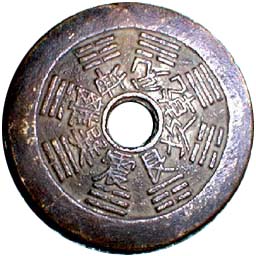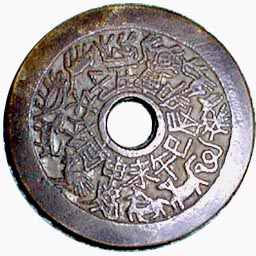The sets of three bars are called Trigrams. According to legend these trigrams were invented 4500 years ago by Fu Hsi in the earliest version of the I Ching. (Later the I Ching was expanded to include 64 Hexagrams, or groups of six bars). The long bar is the Yang or male element, and the divided bar is the Yin or female. Since there are eight possible ways of arranging them, together they are called the Pa Kua, or 8 sides, and they are put into an octagonal shape. Each trigram has its name written above it (towards the center hole). In this picture, beginning from the 3 divided bars in about the 11:00 position clockwise, they are: Kun, Tui, Chien, Kan, Ken, Chen, Sun, and Li. Note: The Li trigram on this coin is engraved incorrectly, it should actually be one broken bar in between two long bars.
This particular ordering of trigrams on this coin is called the Later Heaven arrangement, which represents the practical or mundane. There is another ordering called Early Heaven, which represents the ideal Universe. This coin would be hung inside a "yang" dwelling such as a house or office - I keep it in my car. A charm in the Early Heaven arrangement would be for "yin" dwellings such as graves, or it would be displayed outside a house to deflect harmful spirits.
Each trigram represents a compass direction. Traditionally South is placed at the top. In this case (Later Heaven) South would be Li, Southwest is Kun, etc. Each trigram also represents a family relationship based on the position of the Yin and Yang bars. For example, the 3 unbroken Yang bars of Chien represent the Father, while the 3 Yin bars of Kun are for Mother, and the single Yang bar at the bottom of Chen means Oldest Son. There is rich symbolism associated with the Pa Kua. For example each represents an element (Chen is the dragon, Sun is wood) or an attitude (Chien is creative, Kun is receptive).
The other side of this coin shows the 12 animals of the Chinese zodiac, one for each year. I thought the words written above each animal were their names, but my wife tells me this is not the case. The words are the names of the 12 time divisions in a day, according to the old style of telling time. She could only remember about half the names. Starting from the top clockwise, she knew Chau, ?, ?, Sun, Gei, Ng, ?, Sun, ?, Mau, ?, Ji. Maybe someone could explain this time system better.
|
 or "Yan Sheng Zhu"
or "Yan Sheng Zhu" , other more popular names for charm are "Hua Chien"
, other more popular names for charm are "Hua Chien"  [flower coin] or "Wan Chien"
[flower coin] or "Wan Chien"  [play coin]. They were used as amulet against evil and not as money, so that the Chinese collectors seldom collect them. It is very difficult to trace
the history and developments of Hua Chien, but the mintage of Hua Chien began as early as the Han Dynasty. Actually, those we can see were cast during the recent 100 years. That type of coins normally bear auspicious characters on the obverse side. On the reverse side were various designs of double fish, dragon and phoenix, stars, sword, tortoise and snakes, etc. Hua Chien is only used as an ornament or an amulet to expel or keep away evil spirits and unpropitious influences and not as money.
I have placed below an item received from Mr. Rugh, Jim.
I am very happy that
[play coin]. They were used as amulet against evil and not as money, so that the Chinese collectors seldom collect them. It is very difficult to trace
the history and developments of Hua Chien, but the mintage of Hua Chien began as early as the Han Dynasty. Actually, those we can see were cast during the recent 100 years. That type of coins normally bear auspicious characters on the obverse side. On the reverse side were various designs of double fish, dragon and phoenix, stars, sword, tortoise and snakes, etc. Hua Chien is only used as an ornament or an amulet to expel or keep away evil spirits and unpropitious influences and not as money.
I have placed below an item received from Mr. Rugh, Jim.
I am very happy that
